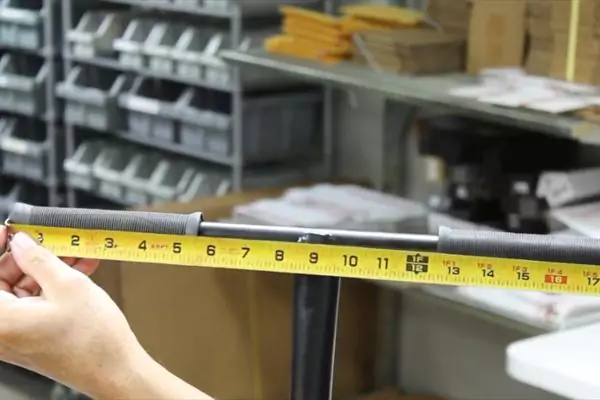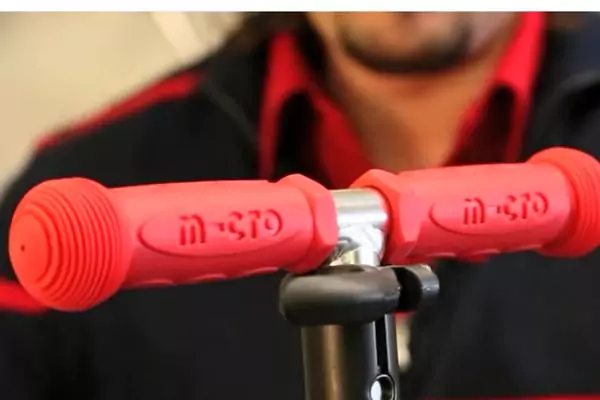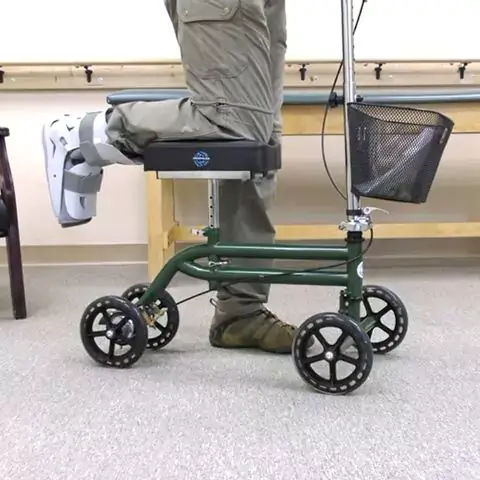Scooter handlebars should be at a comfortable height, usually around waist level to allow for easy maneuverability and control. The correct height of scooter handlebars ensures a comfortable riding position and reduces strain on the arms and back.
When it comes to the optimal height for scooter handlebars, it’s crucial to find a balance between too high, which can cause discomfort, and too low, which can lead to poor steering control. The ideal handlebar height can vary depending on the rider’s height and personal preference.
Ensuring the handlebars are at the right height is essential for a safe and enjoyable riding experience. It’s important to consider the rider’s comfort and control when determining the appropriate handlebar height. Additionally, maintaining the correct handlebar height can prevent potential injuries and enhance overall riding performance.
Contents
- 1 Choosing The Right Handlebar Height
- 2 Ergonomics Of Scooter Handlebars
- 3 Measurement Techniques
- 4 Riding Styles And Preferences
- 5 Safety Considerations
- 6 Impact On Body Posture
- 7 Effect On Riding Performance
- 8 Summary And Recommendations
- 9 Frequently Asked Questions
- 10 What Is The Ideal Height For Scooter Handlebars?
- 11 Final Thoughts
Choosing The Right Handlebar Height

Choosing the right handlebar height for your scooter is crucial for ensuring a comfortable and safe riding experience. The handlebars play a significant role in the overall control and maneuverability of the scooter, so finding the perfect height is essential. Let’s delve into the factors that should be considered when determining the ideal handlebar height for your scooter.
Factors To Consider
When choosing the handlebar height for your scooter, several factors should be taken into account to ensure an optimal fit for your riding style and body dimensions.
Rider’s Height
The rider’s height is one of the most crucial factors to consider when determining handlebar height. Taller riders generally require higher handlebars to maintain a comfortable riding posture, while shorter riders may need lower handlebars to ensure proper control and maneuverability.
Riding Style
Consider your preferred riding style. For instance, if you enjoy cruising at higher speeds, lower handlebars may provide better aerodynamics and stability. On the other hand, for leisurely rides and casual cruising, higher handlebars could offer improved comfort and better visibility.
Comfort and Ergonomics
It’s essential to prioritize comfort and ergonomics. The handlebar height should align with your natural arm position, allowing for relaxed and stress-free riding. Additionally, consider how the handlebar height affects your wrist and back comfort during extended rides.
Maneuverability
The handlebar height directly impacts the maneuverability of your scooter. Higher handlebars can provide better leverage and control for steering, while lower handlebars may improve stability and precision when taking sharp turns and navigating through tight spaces.
Scooter Type and Model
Each scooter type and model may have specific handlebar height recommendations based on its design and intended use. Refer to the manufacturer’s guidelines or consult with a professional to determine the optimal handlebar height for your specific scooter model.
Ergonomics Of Scooter Handlebars

The ergonomics of scooter handlebars play a crucial role in determining the overall comfort and control of a rider. One of the key factors in this regard is the height of the handlebars. Having the proper handlebar height not only impacts the rider’s posture and comfort but also affects the overall handling and maneuverability of the scooter. In this article, we will delve into the importance of proper handlebar height and how it influences the ergonomics of scooter riding.
Importance Of Proper Height
Choosing the right height for scooter handlebars is essential for ensuring a comfortable riding experience. Proper handlebar height is directly linked to the rider’s posture and overall ergonomics. When the handlebars are set at an appropriate height, it helps in maintaining a natural and relaxed riding position, reducing strain on the arms, shoulders, and back. This can contribute to a more enjoyable and less fatiguing ride, especially during longer journeys.
Impact On Comfort And Control
The height of scooter handlebars also has a significant impact on the rider’s comfort and control. Optimal handlebar height can enhance the rider’s ability to maintain a balanced and stable posture, particularly when navigating through varying terrain or making sharp turns. It directly influences the rider’s leverage and control over the scooter, promoting a more responsive and intuitive riding experience.
Measurement Techniques
In finding the ideal height for scooter handlebars, accurate measurement techniques are crucial for a comfortable and safe riding experience. By following specific steps, riders can ensure that their handlebars are set at the optimal height to avoid discomfort and maintain control while on the road. Let’s explore the measurement techniques that can help in determining the appropriate handlebar height for scooters.
Finding The Ideal Height
When determining the ideal height for scooter handlebars, it’s essential to start with the rider’s posture. The handlebars should be at a height that allows the rider to maintain a relaxed and upright position, reducing strain on the back and shoulders. For an accurate measurement, follow these steps:
- Stand the scooter upright on a level surface and position it as if someone were riding.
- Measure the distance from the ground to the center of the handlebar grips. This measurement will be the starting point for further adjustments.
- Consider the rider’s physical proportions and comfort preferences when determining the ideal height. Some riders may prefer slightly higher or lower handlebars based on their individual needs.
Practical Adjustments
After initially setting the handlebars to the measured height, riders may need to make practical adjustments based on their riding style and comfort level. It’s essential to consider the following factors for fine-tuning the handlebar height:
- Test ride the scooter to evaluate the comfort and control with the adjusted handlebar height.
- Pay attention to any discomfort or strain experienced in the back, shoulders, or arms during the test ride, as this may indicate the need for further adjustments.
- Gradually increase or decrease the handlebar height in small increments until the rider feels at ease and in control while riding the scooter.
Riding Styles And Preferences

When it comes to riding a scooter, the height of the handlebars plays a crucial role in ensuring comfort, performance, and safety. Riders have different preferences and styles when it comes to handlebar height, and understanding these aspects can help in customizing the handlebars for individual comfort and performance.
Customizing Handlebars
Customizing handlebars to suit specific riding styles and preferences is essential for an optimal riding experience. Whether it’s for cruising, freestyle riding, or commuting, adjusting the handlebar height can significantly impact the overall handling of the scooter. For instance, riders who prefer a more upright position may opt for higher handlebars, while those who seek a more aggressive stance may choose lower handlebars. Customizing handlebars based on riding style can enhance control and maneuverability.
Individual Comfort And Performance
Each rider has unique comfort and performance preferences, and handlebar height directly influences these aspects. Adjusting the handlebars to align with the rider’s body proportions and riding style can prevent discomfort and fatigue during long rides. By finding the optimal handlebar height, riders can achieve a balanced posture, enabling better weight distribution and reduced strain on the arms and back. This, in turn, enhances overall performance and enjoyment of the riding experience.
Safety Considerations
When considering the height of scooter handlebars, safety should always be the top priority. Proper handlebar height not only ensures a comfortable ride but also plays a crucial role in your safety. Here are important safety considerations to keep in mind:
Influence On Maneuverability
The height of scooter handlebars directly affects the maneuverability of the vehicle. Handlebars set at an appropriate height enable the rider to navigate smoothly and respond to changes in the road or terrain. Adjusting the handlebars to an optimal height can enhance your control over the scooter, reducing the risk of accidents or collisions.
Avoiding Muscle Strain
Improper handlebar height can lead to muscle strain and discomfort during prolonged rides. When the handlebars are too low or too high, it can force the rider into an uncomfortable posture, leading to strain in the back, shoulders, and wrists. By setting the handlebars at the right height, the rider can maintain a natural and relaxed position, minimizing the risk of muscle fatigue and injury.
Impact On Body Posture
When it comes to riding a scooter, the height of the handlebars can have a significant impact on your body posture. Finding the right handlebar height is crucial to ensure a comfortable and ergonomic riding experience. Let’s explore how the handlebar height can affect your body posture and riding comfort.
Ergonomic Alignment
Proper ergonomic alignment is essential for maintaining a healthy and comfortable riding posture. The height of the scooter handlebars plays a critical role in achieving this alignment. When the handlebars are set at the correct height, it allows for a natural and relaxed position for your arms, shoulders, and back. This helps to reduce strain and fatigue during long rides, promoting a more comfortable and enjoyable experience.
Avoiding Discomfort And Fatigue
Incorrect handlebar height can lead to discomfort and fatigue, impacting your overall riding experience. If the handlebars are too low, it can cause excessive strain on your lower back and wrists, leading to discomfort and potential injury. On the other hand, handlebars set too high can cause shoulder and neck strain, leading to fatigue and reduced riding endurance. Finding the optimal handlebar height is crucial to avoid these issues and maintain a balanced and comfortable riding posture.
I hope this helps! Let me know if you need further assistance.
Effect On Riding Performance
Adjusting the handlebar height of a scooter can significantly impact the riding performance. Proper handlebar height not only ensures comfort but also plays a vital role in enhancing control, responsiveness, speed, and maneuverability of the scooter. In this article, we will delve into the effect of handlebar height on riding performance, focusing on handling and responsiveness, as well as its impact on speed and maneuvering.
Handling And Responsiveness
Appropriate handlebar height is crucial for optimal handling and responsiveness of a scooter. Higher handlebars enable the rider to maintain an upright posture, resulting in better control and stability. On the other hand, lower handlebars might offer improved aerodynamics but can compromise the rider’s ability to steer quickly and navigate obstacles effectively. Finding the right balance in handlebar height is imperative for a smooth and responsive riding experience.
Impact On Speed And Maneuvering
The handlebar height directly affects the speed and maneuverability of the scooter. Higher handlebars allow the rider to have a wider field of vision and better leverage, promoting quick twists and turns, essential for navigating through congested areas. Conversely, lower handlebars may provide a more streamlined position, contributing to better aerodynamics and potentially higher speeds on straightaways but could limit the ease of maneuvering in tight spaces. Striking the balance between handlebar height and speed capabilities is essential for maximizing overall scooter performance.
Summary And Recommendations
In this section, we will provide a summary of the importance of correct handlebar height on scooters and offer actionable recommendations for adjusting handlebars to achieve optimal alignment.
Importance Of Correct Handlebar Height
Having the correct handlebar height on your scooter is crucial for comfortable and efficient riding. A handlebar that is too low can cause strain on your back and arms, while one that is too high can affect your control and balance. Additionally, the correct handlebar height contributes to better posture and reduces the risk of injuries and fatigue during prolonged rides.
Tips For Optimal Adjustment
- Start by ensuring that the handlebars are parallel to the front wheel and centered on the scooter stem.
- Adjust the height incrementally, testing the comfort and stability after each adjustment.
- Consider the rider’s height and preferences, making sure the handlebars are at a comfortable level where the rider can maintain a relaxed and upright posture.
- Secure the handlebars firmly in place once the optimal height is achieved to prevent any unexpected movement while riding.
Frequently Asked Questions
What Is The Ideal Height For Scooter Handlebars?
The ideal height for scooter handlebars should be at waist height when standing on the scooter. This position allows for better control and maneuverability while riding.
How Do I Determine The Right Handlebar Height For My Scooter?
To determine the right handlebar height for your scooter, stand on it and adjust the handlebars to a level where they reach your waist. It’s essential to ensure a comfortable riding position and optimal control.
Can I Adjust The Handlebar Height On My Scooter?
Yes, many scooters allow you to adjust the handlebar height to suit your preference and riding style. Check the manufacturer’s instructions to properly adjust the handlebars for your specific scooter model.
Final Thoughts
Ultimately, the height of scooter handlebars should provide comfortable and safe riding for users. Finding the right handlebar height is crucial for a smooth and enjoyable experience. By considering your height, riding style, and comfort, you can determine the ideal handlebar height for your scooter.
Keep riding safely!


